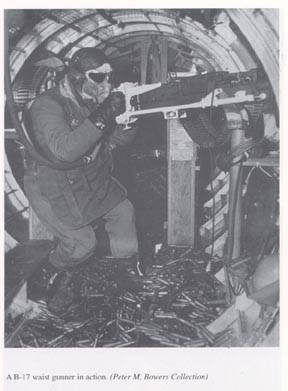Duties and Responsibilities of
THE GUNNERS
Excerpt from the Pilot Training Manual
for the B-17 Flying Fortress
The B-17 is a most effective gun platform, but its
effectiveness can be either applied or defeated by the
way the gunners in your crew perform their duties in
action.
Your gunners belong to one of two distinct
categories: turret gunners and flexible gunners.
The power turret gunners require many mental and
physical qualities similar to what we know as inherent
flying ability, since the operation of the power turret
and gunsight are much like that of airplane flight
operation.
While the flexible gunners do not require the same
delicate touch as the turret gunner, they must have a
fine sense of timing and he familiar with the rudiments
of exterior ballistics.
All gunners should be familiar with the coverage area
of all gun positions, and be prepared to bring the
proper gun to bear as the conditions may warrant.
They should be experts in aircraft identification.
Where the Sperry turret is used, failure to set the
target dimension dial properly on the K-type sight will
result in miscalculation of range.
They must be thoroughly familiar with the Browning
aircraft machine gun. They should know how to maintain
the guns, how to clear jams and stoppages, and how to
harmonize the sights with the guns. While participating
in training flights, the gunners should be operating
their turrets constantly, tracking with the flexible
guns even when actual firing is not practical. Other
airplanes flying in the vicinity offer excellent
tracking targets, as do automobiles, houses, and other
ground objects during low altitude flights.
The importance of teamwork cannot he overemphasized.
One poorly trained gunner, or one man not on the alert,
can be the weak link as a result of which the entire
crew may be lost.
Keep the interest of your gunners alive at all times.
Any form of competition among the gunners themselves
should stimulate interest to a high degree.
Finally, each gunner should fire the guns at each
station to familiarize himself with the other man's
position and to insure knowledge of operation in the
event of an emergency.
|
